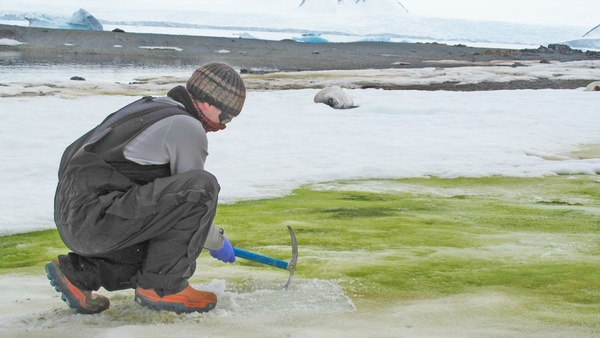Antarctica is the world's southernmost continent, typically known as a frozen land of snow and ice. But terrestrial life can be abundant, particularly along its coastline. Although each individual alga is microscopic in size, when they grow en masse they turn the snow bright green.
That already happens, snow algae are a key component of the continent's ability to capture carbon dioxide from the atmosphere through photosynthesis. But they grow in 'warmer' areas, where average temperatures are just above zero degrees Celsius during the austral summer - the Southern Hemisphere's summer months of November to February.

Dr. Matt Davey at Lagoon Island, Antarctica. Image: Sarah Vincent
The Peninsula is the part of Antarctica that, if measurements from a century ago were accurate, experienced the most rapid warming. The team used images from the European Space Agency's Sentinel 2 satellite taken between 2017 and 2019, and combined these with measurements they made on the ground in Antarctica at Ryder Bay, Adelaide Island, and the Fildes Peninsula, King George Island.
"We identified 1679 separate blooms of green algae on the snow surface, which together covered an area of 1.9 km2, equating to a carbon sink of around 479 tonnes per year" said Dr. study leader Dr. Matt Davey from the University of Cambridge. Put into context this is the same amount of carbon emitted by about 875,000 average car journeys in the UK.
Almost two thirds of the green algal blooms were on small, low-lying islands with no high ground. As the Antarctic Peninsula warms due to rising global temperatures, these islands may lose their summer snow cover and with it their snow algae. However, in terms of mass, the majority of snow algae is found in a small number of larger blooms in the north of the Peninsula and the South Shetland Islands, in areas where they can spread to higher ground as low-lying snow melts.
"As Antarctica warms, we predict the overall mass of snow algae will increase, as the spread to higher ground will significantly outweigh the loss of small island patches of algae," said Dr. Andrew Gray, lead author of the paper from the University of Cambridge.
It is not temperature alone that matters. The distribution of green snow algae is also strongly influenced by marine birds and mammals, whose excrement acts as a highly nutritious natural fertilizer and accelerates algal growth. Over 60 percent of blooms were found within two miles of a penguin colony. Algae were also observed growing near the nesting sites of other birds, including skuas, and areas where seals come ashore.





Comments